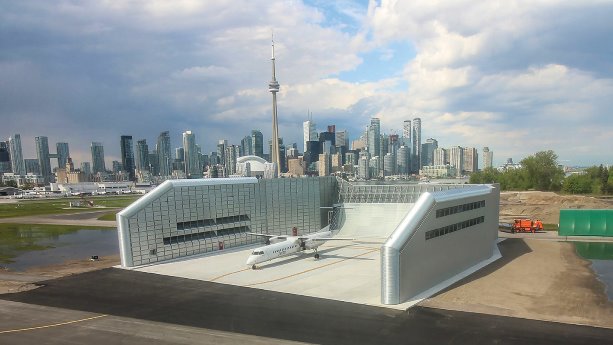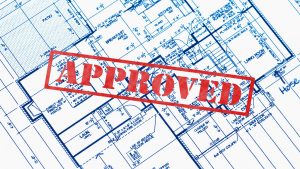Toronto’s Billy Bishop airport has unveiled a new addition to its facilities. The new concrete and steel Ground Run-up Enclosure (GRE) was officially opened in April and is designed to dampen noises associated with ground run-up operations of high-power aircraft engines.
The three-sided, open-top facility will accommodate commercial aircraft and is located on the south west side of the airfield. It was completed on a $9-million budget, privately funded by Ports Toronto as part of an overall three-year airfield rehabilitation program.
The GRE was designed by Reno, Nevada-based Blast Deflectors Inc. (BDI). The company was founded in 1957 on the cusp of the Space Age, to serve the needs of the U.S. aerospace industry, which was ramping up efforts to test new engines for military jet aircraft.
"These types of tests were much more hazardous than tests of propeller planes," says Don Bergin, president of BDI. "They needed an engineered solution that would allow them to complete the tests and protect personnel and property in the vicinity."
Although the fine-tuned engineering behind a blast deflector is sophisticated, the principle behind it is simple. The blast deflector takes horizontal thrust from aircraft engines and deflects it upward to create a safe space in the area.
The company has engineered dozens of variations on the blast deflector, including models made of non-magnetic aluminum designed to avoid interfering with compass calibration and fibreglass models, designed to avoid interference with radar. However, its core deflector models are made of steel embedded firmly into a concrete base.
"We’ve built our reputation almost entirely on two products," says Bergin. "These are blast deflectors and the GREs."
BDI has designed almost a dozen blast deflectors for Canadian airports. The Billy Bishop project is the second aircraft GRE built in Canada after one built by BDI for Vancouver International Airport. It also designed a combination blast deflector/GRE for standalone engines at GE’s state-of-the art engine testing enclosure at Winnipeg’s James A. Richardson International Airport.
This GRE was supplied by BDI on a sub-contract to Pave-Al Limited, the general contractor on Billy Bishop’s airfield rehabilitation program. The engineering consultant was WSP Global. Electrical work was completed by airfield specialist Tristar Electric Inc., on contract to BDI.
"Pave-AL handled all of the civil work," says Bergin. "They had to excavate, pave it and pour a concrete foundation for the GRE. Since it’s located on an island, you could only excavate so far before hitting water, and that was part of the design challenge."
Pave-AL poured a concrete base 18 inches deep. It then poured a wall base 27 inches deep around the perimeter, with six inches protruding above the deck surface to secure the metal run-up components.
The GRE’s steel walls range from 11 to 14 metres in height and form an enclosure 63 metres wide by 66 metres long. While steel components were pre-engineered and pre-fabricated by BDI in the US, the assembly and bolting of the GRE was handled by Scott Steel Erectors Inc.
Bergin notes that each GRE must be custom designed and engineered.
"You could build a GRE to solve a noise problem in one direction, but you’d need to design the enclosure to avoid noise reflecting from the enclosure in a new direction," he says.
GREs work best when the plane faces a perfect headwind entering the facility. However, the plane’s position is fixed inside the GRE, so a cross wind or tail wind inside the enclosure could create turbulence that might damage the craft during run-up. BDI’s solution for Billy Bishop involved the addition of horizontal vents in the sidewalls, which allow air to enter the enclosure when headwinds are sub-optimal.
"But that creates a new noise problem," says Bergin. "We solved that by lining these vents with our patented Noise Blotter acoustic panels made of perforated steel and a highly absorbent acoustic material. The rounded edges and tops of the enclosure wall and a sloped entry at the front of the GRE also smooth the air entering the enclosure and help create turbulence-free air in non-headwind conditions."
The GRE also includes the first North American application of BDI’s patented VertiVent technology in the rear wall. It provides additional stability under tailwind conditions and avoids recirculation of de-oxygenated exhaust gases which can damage engines.
Under longstanding industry relationships, aircraft manufacturers share engineering data with BDI, allowing the company to design enclosures optimized for specific planes.
One novel requirement of the Ports Toronto contract was the provision of a time-lapse video showing the entire GRE construction process. BDI selected an OxBlue camera, powered by a solar unit to record the progress.
"We took advantage of the camera to monitor the project ourselves" says Bergin. "That way we could get an update on progress on the pavement, for example, every 10 minutes."
Civil work began in September, and assembly of the GRE began in January.










Recent Comments
comments for this post are closed